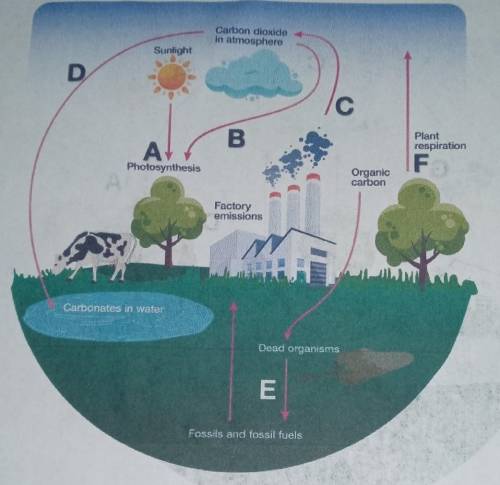NEED HELP ASAP
**Please answer correctly according to the question please** **easy**
Par...

Biology, 04.02.2021 19:40 artistictype4671
NEED HELP ASAP
**Please answer correctly according to the question please** **easy**
Part Two
Carbon dioxide in atmosphere Sunlight D С B Plant respiration A А Photosynthesis F Organic carbon Factory emissions Carbonates in water Dead organisms E Fossils and fossil fuels Text Version Using the diagram above, answer the following questions:
6. True or False. The arrow labeled C represents a transfer of chemical energy to mechanical energy. Explain why this is true or false.
7. True or False. The arrow labeled A represents a transfer of solar energy to chemical energy. Explain why this is true or false.
8. Which arrow or arrows represent a release of carbon dioxide? What process is occurring at the arrow(s) you selected?
9. Which arrow or arrows indicate a process that cycles carbon from living or nonliving organisms? Describe the process or processes you selected.
10. Which arrow or arrows represent reactions that demonstrate a conservation of mass and energy? Explain your answer.


Answers: 3


Other questions on the subject: Biology

Biology, 22.06.2019 01:30, alaina3792
Which of the following shows the correct order in which light information travels through the eye? (2 points) lens, pupil, retina, optic nerve pupil, lens, retina, optic nerve pupil, lens, optic nerve, retina lens, pupil, optic nerve, retina
Answers: 2


Biology, 22.06.2019 10:30, amorrison10181
The eruption of a nearby volcano causes a prairie ecosystem to receive a lot less sunlight. which of these is most likely effect on the ecosystem?
Answers: 2

Biology, 22.06.2019 14:30, mariap3504
The human body needs energy in order to carry out life processes such as breathing. where does the body get this energy? a. from eating food b. from learning about new things c. from lying in the sun d. from sleeping
Answers: 3
You know the right answer?
Questions in other subjects:

Mathematics, 14.07.2019 04:50

History, 14.07.2019 04:50








Mathematics, 14.07.2019 04:50



